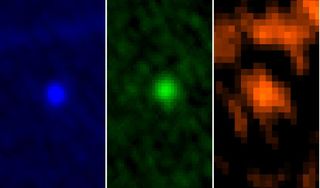6 Asteroids Will Buzz Earth Within a 2-Year Span and Scientists are Psyched

Buckle your seat belts, Earthlings — the late 2020s will offer an incredible spree of close asteroid flybys, and none will pose a threat to life on Earth.
The six flybys of relatively large asteroids will happen over a span of two years, beginning in June 2027. In a presentation given at the International Academy of Aeronautics' Planetary Defense Conference today (April 30) in College Park, Maryland, Lance Benner, a radar specialist at NASA's Jet Propulsion Laboratory in California, walked scientists through the scientific opportunities offered by the flyby series.
"The six asteroids that are going to be coming along will begin in the summer of 2027," Benner said. "And then after that, it's going to be bang, bang, bang — not literally bang, bang, bang, but there will be a number of them coming in very short order, and it should make for a very interesting two years as these objects make close approaches."
None of these asteroids are on paths that will intersect with Earth's orbit.
Related: How a 2017 Asteroid Flyby in 2017 Is Helping NASA Defend Earth
But they'll come close enough that scientists should be able to get a good look at them, Benner said. (In fact, three will be visible with binoculars, and one of those, called Apophis, will be visible to the naked eye.)
The largest asteroid of the lot will swing by first. Called 1990 MU, it is 1.7 miles (2.8 kilometers) wide. Two asteroids in the series will come closer to Earth than the moon's orbit. During the close approaches of all six space rocks, scientists will be able to gather detailed radar imagery of the asteroids, which will give researchers a good sense of the shape and rotation speeds of these objects.
Get the Space.com Newsletter
Breaking space news, the latest updates on rocket launches, skywatching events and more!
In a few cases, scientists will examine these objects for the third time, giving them enough data to begin analyzing the tiny changes in speed that happen when the sun's radiation heats an asteroid unevenly.
And because scientists are aware of the bonanza so far in advance, spacecraft could get in on the fun. Current missions, like NASA's OSIRIS-REx and Japan's Hayabusa2, have shown that machines are now capable of close approaches to space rocks. Future such missions could potentially spot small changes on an asteroid's surface caused by Earth's gravity tugging on the rock during its flyby.
The close approaches will come at a steady clip of two per year beginning in 2027, concluding with Apophis. The bevy of flybys could even offer an opportunity for a spacecraft trajectory that could carry instruments past multiple of these asteroids in the same mission, Benner said.
"I think this is going to attract considerable scientific interest — interest from the public, potentially interest from people who are planning spacecraft missions," he said.
- Humanity Will Slam a Spacecraft into an Asteroid in a Few Years to Help Save Us All
- Photos: Asteroids in Deep Space
- Wow! Asteroid Ryugu's Rubbly Surface Pops in Best-Ever Photo
Email Meghan Bartels at mbartels@space.com or follow her @meghanbartels. Follow us on Twitter @Spacedotcom and on Facebook.
Join our Space Forums to keep talking space on the latest missions, night sky and more! And if you have a news tip, correction or comment, let us know at: community@space.com.

Meghan is a senior writer at Space.com and has more than five years' experience as a science journalist based in New York City. She joined Space.com in July 2018, with previous writing published in outlets including Newsweek and Audubon. Meghan earned an MA in science journalism from New York University and a BA in classics from Georgetown University, and in her free time she enjoys reading and visiting museums. Follow her on Twitter at @meghanbartels.
Most Popular


